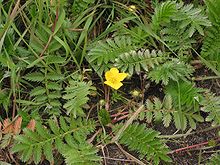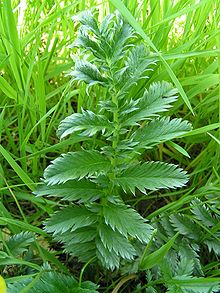- Argentina anserina
-
Argentina anserina 
Scientific classification Kingdom: Plantae (unranked): Angiosperms (unranked): Eudicots (unranked): Rosids Order: Rosales Family: Rosaceae Subfamily: Rosoideae Genus: Argentina Species: A. anserina Binomial name Argentina anserina
(L.) Rydb.Synonyms Potentilla anserina
Potentilla yukonensisArgentina anserina, also known as Common Silverweed, Silverweed Cinquefoil or just "silverweed", is a flowering perennial plant in the rose family Rosaceae. It is native throughout the temperate Northern Hemisphere, often on river shores and in grassy habitats such as meadows and road-sides. The plant was formerly classified in the genus Potentilla but was reclassified into the resurrected genus Argentina by research in the 1990s.[1]
Contents
Habitat and characteristics
Silverweed is a low-growing herbaceous plant with creeping red stolons that can be up to 80 cm long. The leaves are 10-20 cm long, evenly pinnate into in crenate leaflets 2-5 cm long and 1-2 cm broad, covered with silky white hairs, particularly on the underside. These hairs are also present on the stem and the stolons. These give the leaves the silvery appearance from which the plant gets its name.
The flowers are produced singly on 5-15 cm long stems, 1.5-2.5 cm diameter with five (rarely up to seven) yellow petals. The fruit is a cluster of dry achenes.
It is difficult to distinguish A. anserina from A. egedii (the only other species in the genus), the two taxa only differing in characters of the hairs; some botanists treat A. egedii as a subspecies of A. anserina.
Silverweed is most often found in sandy or gravelly soils, where it may spread rapidly by its prolific rooting stolons. It typically occurs in inland habitats, unlike A. egedii, which is a salt-tolerant coastal salt marsh plant.
Cultivation and uses
Herbal tea from the underground roots is used to help delivery, and as antispasmodic for diarrhea. The plant was also put in shoes to absorb sweat. It was formerly believed to be useful for epilepsy, and that it could ward off witches and evil spirits.[2]
The plant has been cultivated as a food crop for its edible roots. The usual wild forms, however, are impractical for this use, as they are small and are hard to clean. It may also become a problem weed in gardens.
Travelers visiting Tibet reported on the food use of the plant's root in the region. According to Pyotr Kozlov, who traveled in the Kham region in 1900-1901, Tibetans, who did not have any vegetables other than turnips, would often dig out roots of Argentina anserina (whose local name he gave as djüma), which could be easily dried and stored for later use. Kozlov even suggested that it would not be a bad idea for Russian peasants to do likewise, especially in famine years. [3] The mission of Sarat Chandra Das to Tibet in the late nineteenth century reported that the root of the plant, under a Tibetan name variously transcribed as toma, doma or droma, was served cooked in butter and sugar at the New Year's celebrations in the Tibetan capital Lhasa. [4]
Etymology and folklore
The pre-Linnaean name anserina means "of the goose" (Anser), either because the plant was used to feed them or because the leaves reminded of the bird's footmarks.
A rich folklore has developed around Silverweed. The plant bears the common name of richette in French, being rich through both silver and gold.
There is a legend that the Christ Child grew up and walked the roads of Palestine; and the yellow flowering plant of the dusty wayside with silvery fern-like leaves that lay flat on the ground has been called the Footsteps of Our Lord.[5]
References
- ^ A key to the Potentilla complex
- ^ Howard, Michael. Traditional Folk Remedies (Century, 1987), p.121.
- ^ P.K.Kozlov, "Монголия и Кам. Трехлетнее путешествие по Монголии и Тибету (1899--1901 гг.) (Mongolia and Kham. Three years' travel in Mongolia and Tibet (1899-1901). Kozlov gives the plant's Latin name as Potentilla anserina, and transcribes its Tibetan name in Russian as джюма (dzhyuma). (Russian)
- ^ http://www.archive.org/stream/journeytolhasace00dass/journeytolhasace00dass_djvu.txt
- ^ Taylor, Gladys. Saints and their Flowers. London, England: A. R. Mowbray & Co., Oxford,1956.
- Lamoureux, G. et al. (1983). Plante sauvage des villes, desa champs et en bordure des chemins. Fleurbec. ISBN 2-920174-07-X.
External links
Categories:- Rosoideae
- Medicinal plants
Wikimedia Foundation. 2010.

